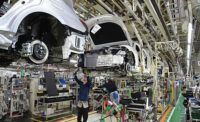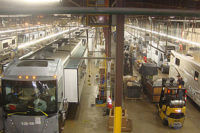All continuous improvement activities at the 2011Assembly Plant of the Yearare tied to lean tools such as 5S, 5 Why and QEK.
Assembly Plant of the Yearare tied to lean tools such as 5S and QEK. “Over the last two years, we’ve focused on using 5 Why analysis as the problem-solving method of choice,” says Eric Kulikowski, senior director of North American operations at Philips Respironics, New Kensington, PA.
“We chose it because it is a simple tool that anyone wanting to determine root cause could use,” Kulikowski points out. “The 5why analysis process details the problem statement and background, problem analysis, alternative actions including feasibility, action plans and a follow up or effectiveness check.
5S (Sort, Set in Order, Shine, Standardize and Sustain) is a lean manufacturing methodology that organizes and manages a workspace and work flow with the intent to improve efficiency and working environment by eliminating waste, improving flow and standardizing processes. “Benefits of this methodology come from deciding what should be kept, where it should be kept, and how it should be stored,” says Stefanie Lozito, continuous improvement leader.
“These decisions are made by a team of associates during a 5S Blitz event,” adds Lozito. “This instills ownership of the process in each associate.”
The QEK (Quick and Easy Kaizen program is a simple continuous improvement program aimed at increasing quality, cost, delivery, safety and morale through employees’ ideas. “Every associate is encouraged to come up with simple or “quick and easy” ideas that could improve his or her particular job activity, job environment or any company process,” says Lozito.
“A lot of small improvements add up to large savings and provide an opportunity for anyone to impact their working environment at any time,” claims Lozito. “This process engages everyone and helps us be a company of problem solvers.”
Last year, Philips New Kensington conducted 38 5Whys and 11 5S events. The plant also implemented more than 2,500 QEKs with 80 percent of employees submitting ideas. “Since their inception, we continue to improve each of these metrics every year,” says Kulikowski. “We also look for other problem-solving tools.”
Within the last two years, the plant has added a wide variety of online and traditional classes to its lean toolbox, including fishbone diagrams, brainstorming, spaghetti diagrams, check sheets and Paretos. “But, we don’t just teach the tools and walk away,” says Lozito. “We bring 5 Why report owners together to talk about lessons learned and different experiences, in addition to making sure that each report owner is well prepared to lead a 5 Why.”
Get our new eMagazine delivered to your inbox every month.
Stay in the know on the latest assembly trends.
SUBSCRIBE TODAY!Copyright ©2024. All Rights Reserved BNP Media.
Design, CMS, Hosting & Web Development :: ePublishing


